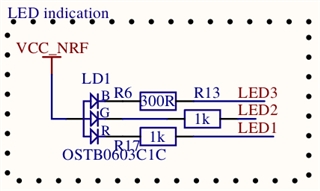I wonder if Nordic reveals electrical schematic of IO buffers?
I have taken some current consumption measurements recently and I have realized that setting a pin as input without pulling can also greatly increase current consumption under some conditions.
Look at below simple part of the circuit.

LED* are directly connected to nRF GPIO port.
RGB leds are sensitive to light and when my device is illuminated by the sun I can realize increase in current consumption (about 300 uA) when LED* are set as INPUT no pulling (I thought this is high impedance state, isn't it?). However when I set LED* as OUTPUT and drive them high there is no increase in current consumption in similar conditions, what is quite obvious cause there is no electric potential difference.
It would be nice if Nordic could share more detailed electrical schematic of IO buffers.
